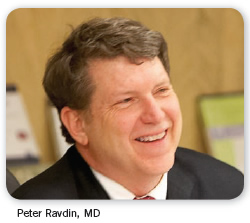| |
Editor’s Note: Age isn’t just a number |
If one were to identify individuals
who have had the greatest recent
impact on daily breast cancer clinical
practice, way up on the list would be
the mop-haired boy genius and numbers
king, Peter Ravdin, MD.
Our prior Patterns of Care studies
have clearly documented the extensive
integration of Peter’s Adjuvant! website
and computer model into medical oncology
practice (Figure 1).
More than half of practicing oncologists
regularly incorporate numbers
derived from Peter’s program into consultation
sessions with patients considering
adjuvant systemic treatment, particularly
people with node-negative tumors contemplating
chemotherapy.
 The impressive uptake of Adjuvant!
has had a profound impact on patient
care. Prior to its advent, medical oncologists
were often criticized for providing
relative risk reduction numbers to
patients, a practice that was confusing
and potentially misleading (eg, telling
a woman with a baseline risk of relapse
of 10 percent that her chance of cancer
relapse could be decreased by 40 to 50
percent with chemotherapy). The impressive uptake of Adjuvant!
has had a profound impact on patient
care. Prior to its advent, medical oncologists
were often criticized for providing
relative risk reduction numbers to
patients, a practice that was confusing
and potentially misleading (eg, telling
a woman with a baseline risk of relapse
of 10 percent that her chance of cancer
relapse could be decreased by 40 to 50
percent with chemotherapy).
Now physicians can just fill in specifics
such as a patient’s age, comorbidities
and basic tumor characteristics, and
Adjuvant! provides easy-to-read graphics
showing the absolute benefit and actual
likelihood that a therapy will prevent an
event (Figure 2).
The program also enables docs to
print the results for use during patient
visits. Clearly, this has been a major boon
to clinical decision-making.

In addition to providing specific numbers
that can be reviewed with patients,
Adjuvant! has become a profoundly
useful tool in managing treatment specifically
for older patients.
Because the program accurately predicts
in aggregate competing causes of
mortality, clinicians can use Adjuvant!
to assess whether it really makes numeric
sense to risk treating a 75- or 85-year-old
patient with chemotherapy.
Peter adopted the raw numbers on
nonbreast cancer mortality from the
SEER Public Registries Files as a basis
for Adjuvant! and it is apparent that age
has a dramatic effect on the estimated
absolute benefits of adjuvant systemic
therapy (Figure 3).
He took the whole process to a new
level in a collaboration with the British
Columbia tumor registry when he verified
the accuracy of the data (Olivotto
2005).
It is amazing to consider how Peter’s
desire to deliver superior and accurate
information to doctors has now been
translated to an enormous impact on
patient well-being.
Perhaps tens of thousands of individuals
have elected to receive therapy
that prevented relapse or death based on
their exposure to Adjuvant! estimates,
and countless others have avoided the
toxicity of treatments because Peter’s
numbers demonstrated that the benefit
wasn’t quite worth it.
The program has become so important
to clinicians that many are currently
clamoring for Adjuvant! to incorporate
HER2 and trastuzumab into the algorithm,
but Peter notes that the adjuvant
trastuzumab data really do not have
adequate follow-up to be incorporated
into his model, which focuses on 10-year
risks of relapse and death.
However, on the way to his devoted
audience is a new version (9.0) that will
incorporate the HER2 story, and you
can bet that the model will be used frequently,
particularly for patients with
lower-risk, node-negative, HER2-positive
disease.

Even now, with a few twists and pulls
you can derive numbers from Adjuvant!
that should be reasonably accurate predictors
of benefit of adding trastuzumab
to chemotherapy (increase the baseline
risk of recurrence by 50 percent, and
decrease the risk of cancer relapse by 50
percent, or some similar machination),
but it will be comforting to use the more
familiar Ravdinian pathways.
One of the most interesting aspects
of Adjuvant! is that for years Peter has
feared that the site might be misleading
to patients who wander in off the
web, and he has tried hard to steer them
away from it. For that reason, to enter
Adjuvant! users must attest that they are
in fact healthcare professionals.
Although Peter in no way wishes to
deny patients access to Adjuvant! (he
believes they should ask their oncologists
to obtain the information), he is
concerned about the potential adverse
consequences of using the site in isolation
without the appropriate background
and understanding of its meaning.
Of interest is the enclosed US-based
survey of 150 randomly selected practicing
medical oncologists and 41 clinical
investigators focusing on breast cancer.
In contrast to Peter’s restrictive position,
many of these physicians believe patients
should be encouraged to consider using
the site (Figures 4, 5).
Peter is actually featured in an in-depth
audio interview on our new
patient education audio/web program,
and his opinions raise a critical question:
Can patients understand sophisticated
models like Adjuvant!, and particularly
the concept of the effect of age on treatment
impact?
Certainly only a highly motivated
subset of patients will wish to become
that involved with their oncologic care,
but “the waiting room and infusion center
theory of cancer information dissemination”
would postulate that educating
10 to 20 percent of a patient population
will result in a significant spillover to
other patients who chat together.
Thus it may be that many of the key
concepts in Adjuvant! are already affecting
the collective patient consciousness.
Peter is one of the coolest guys in
oncology, and as is often the case with
such people, he is truly humble about his
work. We need to encourage other creative
thinkers and inventors to come up
with new methods to make the best decisions
possible for people with cancer.
— Neil Love, MD
NLove@ResearchToPractice.net



Select publications
|
